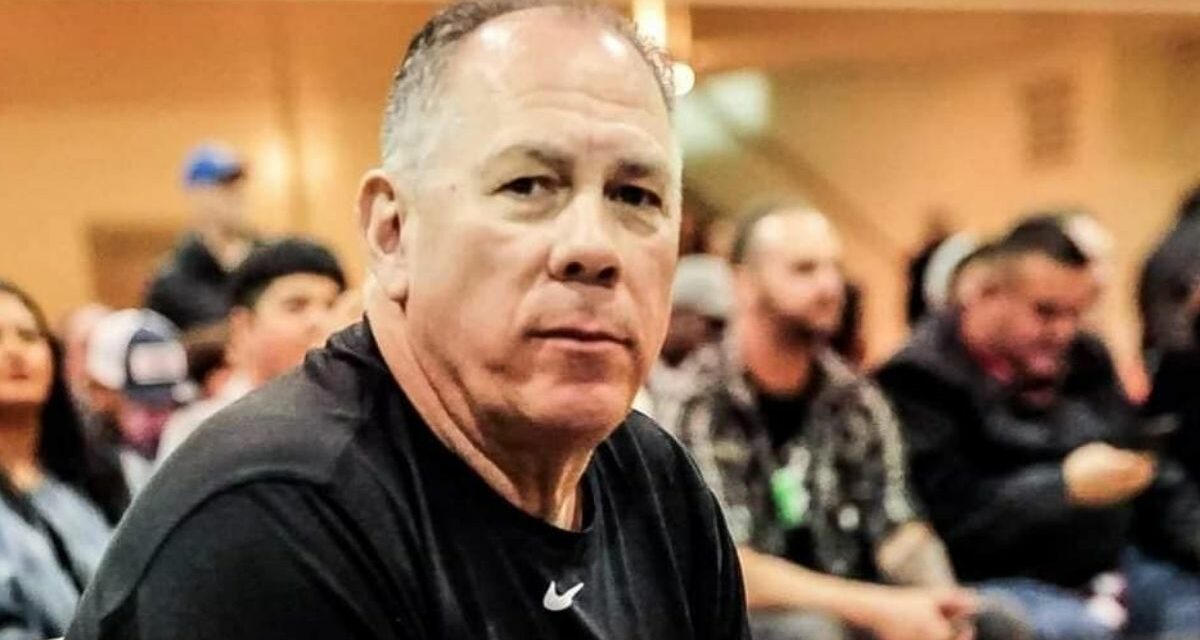It’s been almost three months since long-time Northern California promoter Kirk White died on Christmas Eve at only 63. While waiting at the time for more information on the status of Kirk’s Big Time Wrestling promotion and possible tribute wrestling show, I wanted to share my thoughts on his life from knowing him since he was just a fan. I later became his first event photographer well before BTW’s start, also helping him for years with public relations, contacting talent and more. Kirk was a complex person, and difficult to be friends with in his later years, something I have heard from people far closer to him than I was. But there’s no denying the success of his typically packed shows every few months, his signings, fanfests and influence.
To truly note what Kirk meant to the Bay Area, experts encouraged me to discuss wrestling promotional history here. While it goes back even further, important promoter names really blossomed in 1935 with Joe Malcewicz — a former hooker/wrestler nicknamed “The Utica Panther” — running primarily in San Francisco. Then Roy Shire moved west and aggressively pushed Malcewicz out, taking over in December 1960 with weekly television well before Shire ran his first card. His last event was also his last annual 18-man battle royal in January 1982. On my TV show in 1990, Shire said that he knew that both Verne Gagne’s AWA and Vince McMahon Jr.’s WWF were coming to Oakland and San Francisco “to pick my bones once I retired.” Shire was Kirk’s idol. “Professor” Roy had learned much in Jim Barnett’s Indiana circuit as well as in Ohio and even working for Malcewicz in the mid 1950s. He quickly took over what he called “Gentle Joe’s territory,” predominantly with his television mastery amidst exciting shows. Malcewicz was vulnerable at that point. There was initial uproar like from NWA President Sam Muchnick over this “outlaw promotional takeover.” But Shire and his Big Time Wrestling promotion eventually joined the NWA on August 8, 1968, and Shire even served as NWA Vice-President in the early 1970s.
Fast forward, and WWF beats AWA in the battle for Northern California but then only comes to the area a few times a year. It left spots for an aggressive independent promoter like Kirk would become, to exist and eventually thrive.
But first, where we met. Kirk came up to me during intermission at one of Shire’s shows at the Cow Palace, asking if I could sell him some of the photos I had taken at the shows, top names like Ray Stevens, Pat Patterson, Prince Peter Maivia (not yet a High Chief), Pepper Martin, Pepper Gomez, Rocky Johnson. At this point, I was listed as “the official photographer” for BTW’s Action Wrestling Magazine, and I had articles and photos in newsstand magazines like Norm Kietzer’s many titles, as well as Wrestling Guide, Big Book Of Wrestling, and more.
Woody Farmer, who wrestled for Shire and others for years before settling permanently in the Bay Area, was promoting in and around San Francisco; in 1997, Farmer becomes key to White’s story.
Fan fests in the 1970s were exactly that — for the fans; the WFIA conventions were a place for fans who had corresponded through the magazines and the few newsletters to congregate. In 1991, John Arezzi introduced his Weekend of Champions, where he brought in stars to meet the fans as a commercial venture, and it took another decade before those kind of shows propagated. In 1998, Kirk began holding small autograph signings at his sports collectible store and soon at larger venues like East Bay high schools. He felt fans wanted to meet past legends and whichever current ones he could get access to.
I gave Kirk contacts for long-time Shire stars Jimmy Snuka and Buddy Rose plus names like Greg Valentine, Brutus Beefcake and Tito Santana. Woody was a big help too, helping Kirk, but also even asking talent not to overcharge or work Kirk on price.
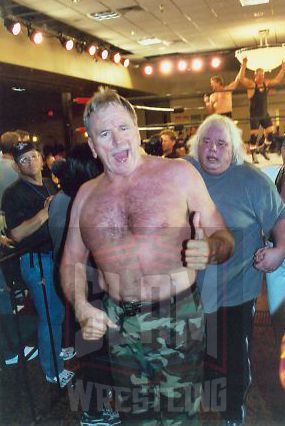
Col. DeBeers and Playboy Buddy Rose at a Kirk White BTW show. Photo by Mike Lano, WReaLano@aol.com
California wrestling changed massively once Shire retired in early 1981 and Mike Lebell, who ran Southern California territory, sold his circuit to Vince McMahon Jr in December 1982. Two legends gone.
Farmer and former fellow Shire workers, like Alexis Smirnoff and Jerry Monti, tried promoting individually here but wouldn’t work together to improve their houses. Kirk and I were at most of their shows, helping those promoters, and he’d help me with my ringside camera equipment too. Kirk often asked why those veteran wrestlers “wouldn’t just work together, combine talent so they can stay in business.” Kirk was impressed that at least Monti held a “sold” show drawing 1,121 at the Vallejo County Fairgrounds where fans who paid to get into the overall county fair got to see wrestling for free. But Monti’s next house show at a VFW hall drew poorly.
It wasn’t until Roland Alexander’s APW began in 1993 that NorCal had a wrestling resurgence. Armed with his own young up-and-coming APW trained talent like Mike Modest, Donovan Morgan, San Francisco State amateur champ Tony Jones, Mike Lockwood (later Crash Holly), Alexander raised the bar for what Bay Area home-grown wrestling shows could be like.
A devoted fan of Roy’s mystique, Kirk said he “always wanted to follow in Roy’s shoes.” It started with the periodic signings, and then came Kirk’s cable access show in Newark (just north of San Jose). About two years about APW began, Kirk finally started promoting shows himself, capitalizing on their area buzz; he called his promotion “Big Time Wrestling” in tribute to Shire’s promotion.
He’d soon find the answer to his own question about local promoters not working together. “I don’t want to answer to anyone else. Just to myself, whether I flop or do great,” Kirk said.
Farmer once again was key, actually ceding his weekly cable access TV slot at the tiny Newark United Artist Cable station to White and his BTW. Farmer had grander plans, and had just signed a deal with Comcast to produce a nationally-aired weekly Bay Area cable TV show in a much larger location in nearby Fremont; “The Great” Mae Young trained his talent and helping with the book. Woody’s son, Rex, wrestled as Hawkeye Shane Cody and he worked some of Kirk’s earliest shows, right through the last ones.
With APW in competition, Kirk revamped his shows, and wanted to bring in additional talent. I hooked him up with names like Japan’s JWP touring star Reggie Bennett and her own student Jessica “Black Ice” Sato. They had outstanding TV matches, helping draw SRO crowds for the free tapings. Newark is a small, blue collar town just north of San Jose and south of Oakland, part of a large conglomerate of cities called The East Bay. The location suited Kirk, who became immersed in the local pro sports scene — the NFL’s Oakland Raiders, baseball’s Oakland A’s, and the NBA’s Golden State Warriors — through his store. After his signings began drawing consistent crowds, Kirk said, “It’s time to promote a real card that people pay money to come see.”
Outside of the Farmers, Kirk’s other key figure was his longtime lead heel “Irresistible” Jason Styles, who served as BTW champion and head trainer at Kirk’s wrestling school. Styles usually wrestled the name fly-in talent like Kamala, Tito Santana and Jay Lethal in the main events. The biggest name to come out of their school was WWE’s Bayley, who began wrestling as Davina Rose. When White and Styles had a falling out years later, BTW wrestler L’Empereur (originally from the touring Incredibly Strange Wrestling group) reportedly took over for Styles in training BTW talent and overseeing booking. Allan Bolte was BTW’s announcer and commentator, and he had ties to Incredibly Strange Wrestling as well. There were times when Allen couldn’t be there, and Kirk’s friend Jim Davis handled the ring announcing.
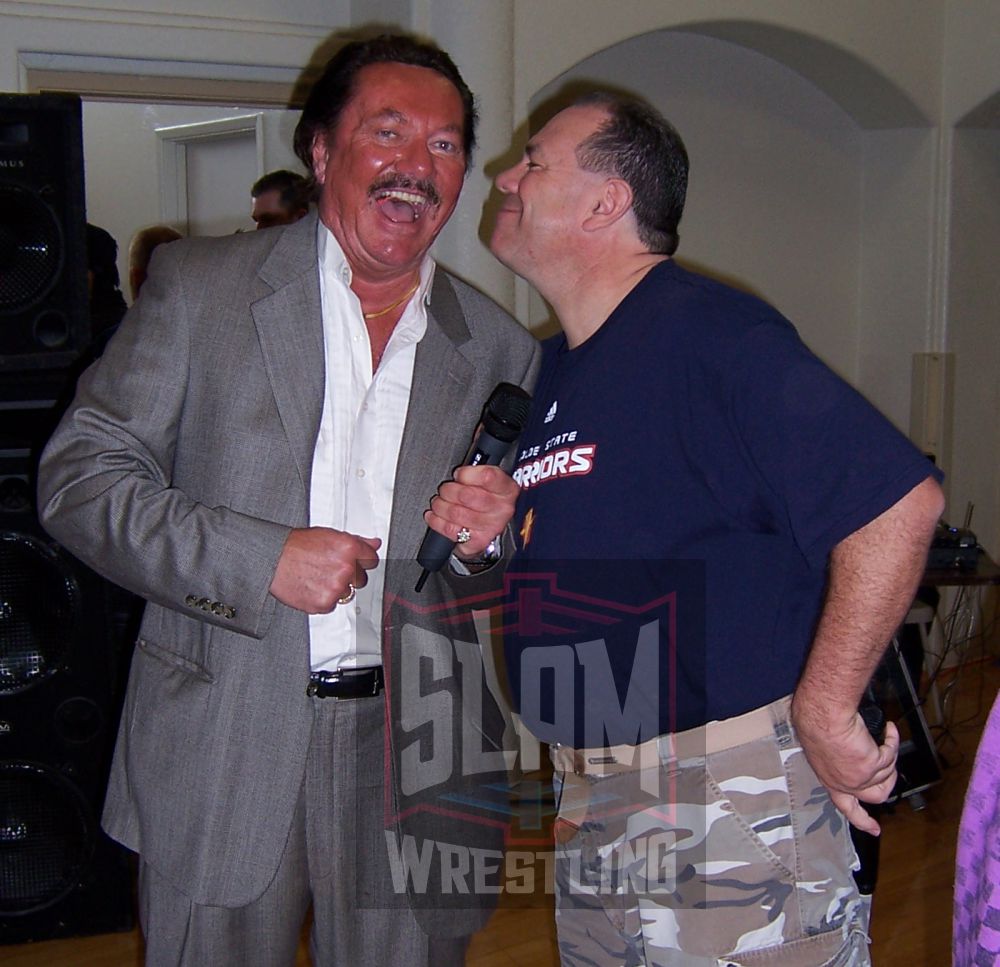
Allan Bolte and Kirk White. Photo by Mike Lano, WReaLano@aol.com
Styles was hardly the only one to have a falling out with White. To me, Kirk was complex and he put a lot of pressure on himself and others, and that sometimes meant yelling at volunteer BTW staff and even some of the talent (though not the big names). Kirk would blow it off saying, “it’s just like Shire,” as Shire also had a temper and many wrestlers refusing to work with him. (Great Mephisto / Frankie Cain one slapped Shire in front of the boys and quit the territory).
Bolte was not immune. Every so often, Kirk wanted a new announcing voice, but didn’t tell Bolte in advance. He’d briefly try Ron Hed, Jeff “JR” Benson and others, only to apologize and bring Bolte back. On one occasion, Kirk posted to social media that was trying out a new female announcer, starting that evening. Bolte later told me, “it broke my heart again, but she didn’t last long and I was back quickly after an apology.”
Back to paying more tribute to his hero, Kirk also bought several items from Shire’s estate, including the trophy Roy presented each January to his annual 18-man battle royal winners. From then on, whenever Kirk had a battle royal, he’d hand the winner Roy’s famous cup, and, then immediately take it back once they got backstage. Shire did that too.
In the early 2000s, Kirk hit his stride with Big Time Wrestling. He’d usually promote every few months on a Friday or Saturday first in Fremont, California— starting out at Stevenson High School until discovering a “crown jewel” in the Newark Pavilion, which was like a rec-center with several built-in concession areas and a bar. Later he’d add a secondary show hours away the next night, like in Eureka.
It’s important to note that APW and BTW overlapped as APW’s Hayward, California, headquarters was right next door to BTW’s Fremont/Newark California homebase. Plus Kirk often used APW talent to round out his BTW cards. But Alexander and White didn’t necessarily see pro wrestling or their promotions the same way. When Alexander sent in requested APW wrestlers, he’d often come study Kirk’s shows, taking notes on what worked, what didn’t. But the few times Kirk and Styles attended APW’s Gym Wars cards during two attempts at a BTW versus APW promotional feud, Kirk asked to cut his promos right at the start of the show. Then he’d immediately leave, dragging Styles with him, saying he had to go to an A’s or Warriors game. Alexander always felt White should’ve stayed to watch the episodic, carefully planned Gym Wars spectaculars. White in the 2000s really didn’t have the same approach as APW’s and for which APW was getting raves about being amongst the very first to stream its shows live. Both interpromotional feuds fizzled with Alexander blaming White for “not putting more effort into them, not sticking around and not being a student of the biz.” Kirk would say, “Hey, I tried.”
Starting in 2001, APW’s King of the Indies two-day tournament raised the bar and got global attention. Kirk changed his approach, and starting by flying in more than just a single big name for his BTW shows. As well, a third Bay Area group was making waves, Pro Wrestling Iron, which was formed by most of APW’s talent leaving with leaders Mike Modest, Donovan Morgan, Frank Murdoch and Bison Mark Smith. It truly was an APW “civil war” dispute over the news that “outsider” — American Dragon Bryan Danielson — would take over as head APW trainer, as announced by Alexander at King of the Indies, replacing Modest and Morgan. PWIron also took the valuable talent-trading link with Misawa’s NOAH Japan promotion. Gabe Ramirez’ Pro Wrestling Revolution came later after Ramirez and wrestlers/trainers like Robert Thompson also left APW to form the lucha-based promotion plus their own lucha-and-more school.
BTW’s shows had Styles and Farmer on the upper card, and Styles’ trainees like Wild Storm and Davina Rose in the mix; the Ballard Twins were regulars too. Kirk himself would often do the in-ring interviews with some of the big names he’d flown in — and he started to enjoy the spotlight, even if it was a little disrespectful to Bolte, who had done them for years. Kirk told me he thought he did his best mike work interviewing former APW trainee/star Matt Hyson (later ECW’s Spike Dudley) and his opponent Justin Credible before their fan fest main event.
With a strong history of great signings, Kirk was able to bring in some real A-list talent to the Hayward Shopping Mall, including Matt and Jeff Hardy, Lita, Mick Foley, Stone Cold Steve Austin and The Rock — and that was just in 2001. When TNA gained some momentum, Kirk brought in Samoa Joe, Frankie Kazarian, Christopher Daniels as Curry Man, Jay Lethal, Sabu, and even Scott Hall and Kevin Nash. Many years later, Impact Wrestling globally partnered with indies like BTW to load its talent on outside shows to air on its streaming network. Kirk began conducting his own in-ring interviews(like with frequent autograph signee Bret Hart). “Kirk did have nearly every major name in the business including Hogan come here,” Bolte told me.
Selling the autographs in the store was important. At a 1999 WWF house show in Davis, California, Kirk saw me going backstage and ran up trying to hand me 50 8x10s for Kurt Angle to sign. “I don’t know him. Ask him, he’ll do it for you,” he pleaded. I refused as he needed to properly approach and pay Angle himself. I stood up to him, he backed down and that happened probably because he was now more monetarily-concerned with heightened talent fees which he admitted often stressed him out.
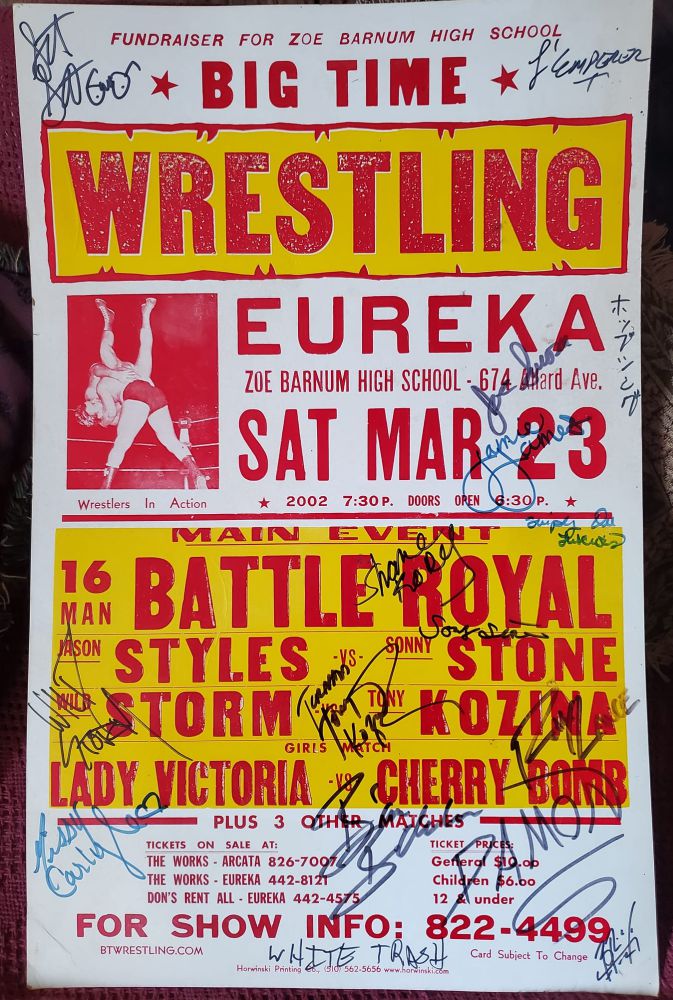
The fly-in talent loved Kirk because he’d often take them to local baseball, football or basketball games. Kirk told me he usually got the tickets comped at his store but paid for everyone’s food and beverages there.
Through the many signings he set up, Kirk became close to Bret Hart, and ended up acting as the Hitman’s de facto West Coast agent plus others like Harry Smith. When news of Kirk’s death broke, Harry tweeted out: “Very sad to hear about the passing of my former manager, agent and friend Kirk White. Kirk also managed managed my uncle Bret Hart for many years. Kirk first brought me to his company BTW in 2005 in the Bay Area, I was his Heavyweight Champion at one point even as a teenager still, and Kirk really gave me lots of opportunities and branched me out first then in the USA. I got to make a lot of friends and have great memories there. Kirk always took great care of me, never steered me wrong and was always in good hands with him. He used to take me to my favorite Greek diner in Newark CA also … R.I.P Kirk. Thanks for everything.”
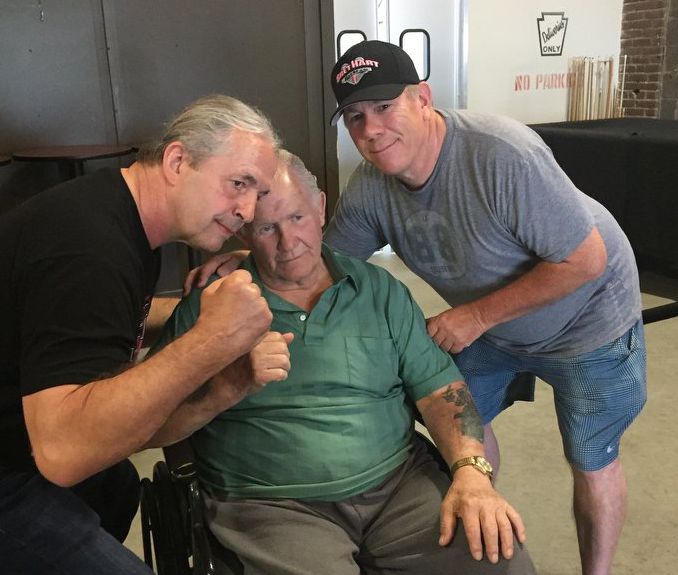
Bret Hart, Harley Race and Kirk White. Facebook photo
With his all-day fan fests growing in popularity, Kirk nagged me and others routinely for more name contacts like ODB, Gail Kim, Gangrel, Rob Van Dam and more before he was able to contact WWE and Impact directly. Talent had to be paid for both the signing and then at the BTW show. As well, Kurk showed his good side, accommodating local legends that I arranged to get to his fests like Pepper Gomez, Kinji Shibuya, Mitsu Arakawa, the original Paul Diamond and Ann Calvello from roller derby fame, who was my TV show cohost. Kirk often attended my tapings, thrilled meeting his childhood heroes. At his fests, he’d tell them all he could do was let them keep whatever they made doing autographs and Polaroids. Later on, he’d relent and give them additional cash.
Getting Pat Patterson to a fan fest was really an undertaking. For many months, Kirk nagged me to try to convince Pat to attend. Kirk didn’t really know Pat, other than as a fan. Pat kept telling me he’d never done a fan fest, nor had any desire to, but gave in as a favor to me. When he did agree, there was a condition. “That’s as long as your promoter friend will take us out to dinner at one of my favorite North Beach restaurants. Like Little Joe’s or Lorenzo Patrone’s North Beach Café that I used to go to back in the ’70s. Since you’re asking me, I’ll do it, but I have to go out to eat in the North Beach Italian district in S.F.” Somehow when we picked Pat up at SFO Airport, Kirk finagled it into going instead to unrelated Westlake Joe’s well south of S.F. — similar food but much closer to Kirk’s fan fest hotel for talent. Pat grudgingly agreed, later made happy after some red wine and his favorite Cosmopolitan cocktails prior to the meal. When the check arrived, Pat offered to pay it in jest, never thinking Kirk might hold him to it. Pat became upset again until Kirk took us out for breakfast the next morning pre-fan fest. “How that guy worked a worker, I’ll never get,” Pat told me once he was back to Florida. Pat was the fan fest highlight at the end when he started singing Frank Sinatra songs on a house mike. Old-time Shire fans were ecstatic — as was Kirk.
Kirk’s passing on December 24, 2021, was shocking for someone who had more than a year of events already planned. He is survived by his wife, Laurie, and their daughter Taylor. Laurie at times helped smooth things over behind the scenes, primarily when he began promoting actual wrestling shows.
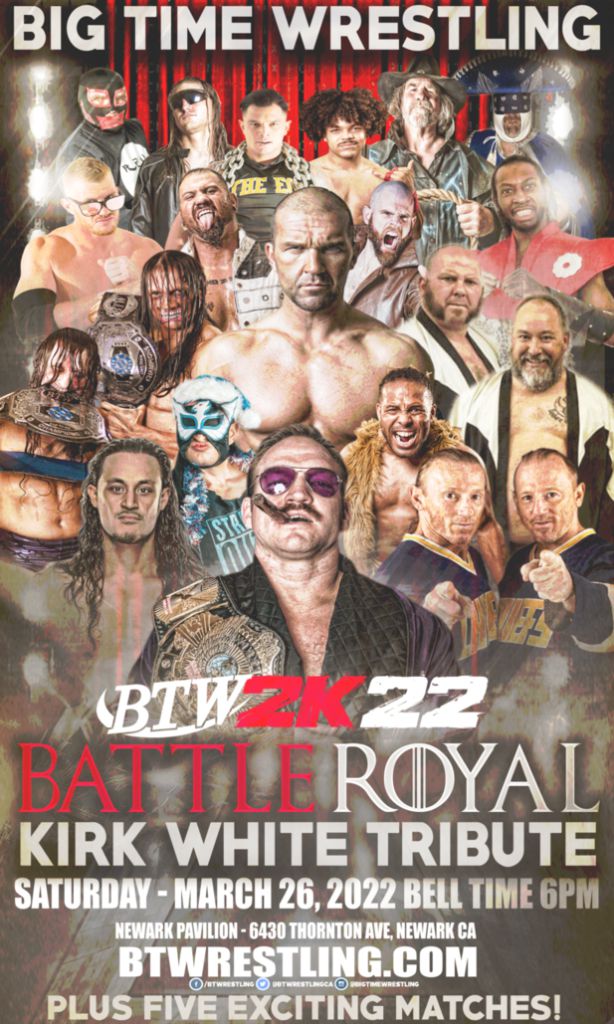
With many of the pandemic restrictions finally loosened in California, there is finally a tribute show to Kirk White. It’s on Saturday, March 26, at the Newark Pavilion, in Newark, California, with a 6 p.m. bell time — but it sold out quickly; fortunately, it will be streamed too. [Tickets here.] Frankie Kazarian, the Ballard Twins and Aaron Solo are some of the bigger names on the show. Area rumors and hopes persist that Kirk’s closest staffers, like Jason Styles, Hawkeye Shane Cody and L’Empereur might continue BTW in some way to continue his NorCal legacy.
TOP PHOTO: Kirk White. Facebook photo
RELATED LINKS
